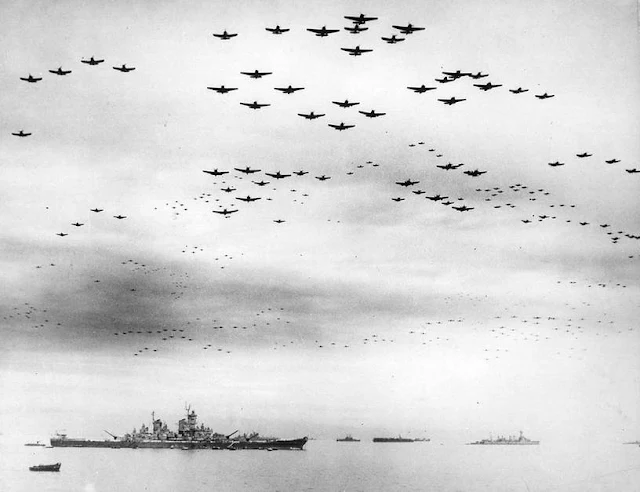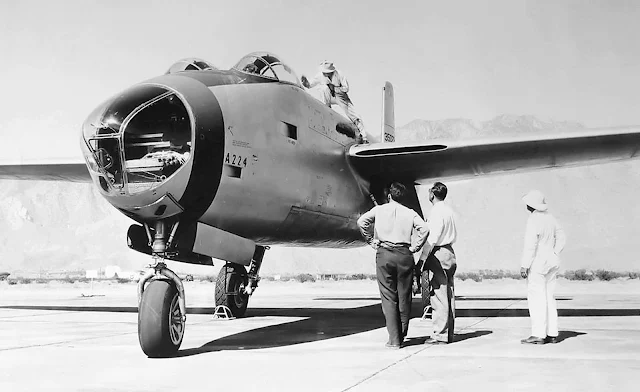 |
| U.S. Navy Grumman F6F-3 Hellcat of Fighter Squadron 1 (VF-1) over California, in early 1943. VF-1 was redesignated VF-5 in July 1943. |
 |
| Lockheed R5O-1 (4250) staff transport for the Secretary of the Navy. At San Francisco on August 4, 1941. |
 |
| Robert S. Johnson in his Republic P-47 Thunderbolt, 13 April 1944. |
 |
| Douglas SBD Dauntless dive bombers approach the burning Japanese cruiser Mikuma during the Battle of Midway, June 6, 1942. |
 |
| Ensign Leif Larsen and rear gunner John F. Gardener in their Douglas SBD-3 Dauntless dive bomber. |
 |
| Black cadets in training for the U.S. Army Air Corps, later become the famous Tuskegee airmen. |
 |
| Douglas A-26 Invader. |
 |
| Douglas A-26B Invader (43-22327) landing at an unidentified airfield. |
 |
| Air raid wardens at a sector meeting in Washington, DC, discuss the zones they control during a practice air raid. |
 |
| Making model airplanes for the U.S. Navy at the Armstrong Technical High School. Washington, D.C. March 1942. |
 |
| Fairchild AT-21 Gunner. |
 |
| Boeing B-17 Flying Fortress being refueled from an RAF fuel bowser. |
 |
| Luftwaffe nemesis. B-17F Flying Fortresses of the Eighth Air Force 390th Bomb Group over Europe; contrails made by their escort fighters curve through the sky above the formation. |
 |
| A B-25 bomber of the U.S. Army 5th Air Force strikes against a Japanese ship in the harbor at Rabaul, New Britain during an air raid on the Japanese-held air and naval base. November 2, 1943. |
 |
| Artist painting artwork on nose of a North American B-25 Mitchell bomber. |
 |
| North American PBJ Mitchell, Marine unit, Guam. |
 |
| Loading practice bombs on a bomb trailer onto a USAAF B-25. |
 |
| US Army Air Forces Martin B-26B Marauder “Dee-Feater” (X2-A; 42-96142) of the 596th BS 397th BG 9th AF with D-Day invasion stripes. |
 |
| Martin B-26 Marauder (41-31669). |
 |
| Martin B-26B Marauder (41-17876) USAAF. |
 |
| This June 6, 1944 photo shows B-26 Marauders flying toward France during the D-Day invasion. |
 |
| This memorandum informs the Army Chief of Staff that another atomic bomb would be available for delivery on August 17 or 18, 1945. |
 |
| This desolated area, with only some buildings standing here and there is what was left of Hiroshima, Japan after the first atomic bomb was dropped. September 3, 1945. |
 |
| The expanding fireball and shockwave of the Trinity test explosion, seen .025 seconds after detonation in the New Mexico desert on July 16, 1945. |
 |
| C-47's dropping supplies for Bastogne. |
 |
| USAAF bomb trailer at a B-26 air base. |
 |
| 20th Pursuit Group P-36As, March Field, California (PT marking P for Pursuit and T for 20th letter in alphabet, note 20th PG shield on side of aircraft). 7 November 1939. |
 |
| 20th Pursuit Group P-36s, Moffett Field, California, 1 July 1939. |
 |
| LBD-1 Gargoyle. |
 |
| Curtiss P-36, USAAC. |
 |
| Curtiss P-36 from Wright Field. |
 |
| Curtiss P-36 Hawks, 32nd Pursuit Squadron, Ponce Airfield, Puerto Rico, 1941. |
 |
| General Dale V. Gaffney is greeted during an inspection trip in 1944 by Colonel N. S. Vasin, the Russian delegation leader in Fairbanks. |
 |
| Another view of the American Red Cross Club mobile with B-17E “Phyllis”. |
 |
| Another view of “Phyllis” with a Red Cross woman passing out donuts to airmen and ground crews. |
 |
| Interstate BQ-4 assault drone prototype, circa 1944. |
 |
| North American BT-9A, March 17, 1941. |
 |
| Vultee BT-13 Valiant, circa 1942. |
 |
| USAAC 1st Lieutenant standing in front of Vultee BT-13 Valiant basic training aircraft on the ground, at an unidentified flying school somewhere in the United States, circa 1943. |
 |
| Beechcraft GB-1 Traveler, U.S. Navy, circa 1939. |
 |
| Beechcraft D17 Staggerwings under construction. |
 |
| Beechcraft GB-1 Traveler in U.S. Navy service. |
 |
| Beechcraft UC-43 Traveler (43-10859), USAAF. |
 |
| Beechcraft UC-43 Traveler (43-10828), USAAF. |
 |
| B-25 Mitchell bomber broke in half from rough landing approach. |
 |
| Vultee BT-13 Valiant. |
 |
| Vultee BT-13 Vibrator (40-1190), the 300th BT-13 built, last of the first batch. |
 |
| American C-24 (32-287), Oakland Airport, 1936. From Gray Field, Washington. |
 |
| U.S. Army Air Forces Beechcraft UC-43 Traveler (43-10859), circa 1944. |
 |
| Beech YC-43 Traveler (39-139), USAAF. |
 |
| U.S. Navy Beechcraft GB-2 Travelers lined up, in early 1943. |
 |
| Beechcraft UC-43 Traveler (43-10828), USAAF. |
 |
| Beechcraft UC-43 Staggerwing, USAAF. |
 |
| Beechcraft UC-43 Traveler (43-10828), USAAF. |
 |
| Beechcraft 17 Staggerwing. |
 |
| A weapons carrier is loaded aboard a C-46 transport which will fly it over the “Hump” to China. |
 |
| Douglas C-47 Skytrains in flight during training at Sedalia Army Air Field, Warrensburg, Missouri, 1944. |
 |
| Douglas C-47 Skytrains in flight during training at Sedalia Army Air Field, Warrensburg, Missouri, 1944. |
 |
| A wounded U.S. Marine is given a plasma transfusion by nurse Mae Olson aboard an aerial evacuation unit, over Guadalcanal, Solomon Islands. June 4, 1943. |
 |
| Douglas C-47 cargo plane on airstrip at Waller Field, Trinidad, British West Indies. April 1943. |
 |
| Air Transport Command Douglas C-47s of the Caribbean Division get the once-over from nose to tail to keep them in perfect condition for the run from Natal, Brazil, to Miami, Florida. |
 |
| Members of the 2nd Service Group load a transport plane at an air base somewhere in Iceland. 23 February 1944. |
 |
| Wreck of Douglas C-47 (41-18514), 2nd Service Group, which crashed somewhere in Iceland. 11 August 1944. |
 |
| Another view of wreck of Douglas C-47 (41-18514), 2nd Service Group, which crashed somewhere in Iceland. 11 August 1944. |
 |
| Noorduyn UC-64 Norseman, USAAF (43-5113), February 9, 1943. |
 |
| Noorduyn UC-64 Norseman (43-5121), USAAF, floatplane version. |
 |
| Noorduyn YC-64 Norseman Mk. IV (42-5046), U.S. Army Air Forces. Carterville Airport, St. Laurent, Province of Quebec, Canada, 1941. |
 |
| Noorduyn YC-64 Norseman Mk. IV (42-5046), U.S. Army Air Forces. Carterville Airport, St. Laurent, Province of Quebec, Canada, 1941. |
 |
| Noorduyn C-64 Norseman (43-5396). |
 |
| Noorduyn C-64 Norseman under various stages of construction, November 4, 1944. |
 |
| U.S. Navy drones available in 1945. |
 |
| Goodyear F2G-1 Corsair. |
 |
| With a 500 pound bomb slung underneath their bellies, a squadron of U.S. Marine F4U fighter planes are ready to take off at a Central Pacific base for another attack on the Japanese. |
 |
| A mechanic hoists up the tail of this F4U at an airstrip on Guadalcanal in order to align the plane’s guns properly. |
 |
| F4U fighters of VF-17 “Jolly Rogers.” |
 |
| An F4U-5 night fighter, armed with four 20-mm AN-M cannon with flash hiders to protect the pilot’s night vision. |
 |
| An F4U Corsair lands on the flight deck of a carrier spewing burning fuel. |
 |
| F4U Corsair “29” of VF-17, the “Jolly Rogers.” |
 |
| F4U Corsair. Note the “Jolly Rogers” unit insignia on the cowling. |
 |
| An F4U Corsair coming in for a landing on board the flight deck of a carrier. |
 |
| Consolidated A-11. |
 |
| Consolidated A-11. |
 |
| Consolidated A-11. |
 |
| Consolidated A-11. |
 |
| Consolidated A-11, serial number 33-211, the last A-11 built. |
 |
| Lockheed A-29, 1st Photographic Reconnaissance Group, USAAF, Alaska, 1941. |
 |
| With the towering 20,300 feet peak of Mt. McKinley as a backdrop, a formation of U.S. Army Air Force Lockheed A-29 Hudsons drone along on the alert in defense in Alaska on November 5, 1942. |
 |
| Vultee A-35 Vengeance US Army Air Forces. This is a target tug conversion with all armament removed. It's difficult to determine whether it's an A or B model. |
 |
| Vultee A-35B Vengeance (42-101465) US Army Air Forces. |
 |
| Working on the horizontal stabilizer of a Vultee A-31 Vengeance dive bomber at the Consolidated-Vultee plant in Nashville. February 1943. |
 |
| A woman drills parts for a dive bomber at the Vultee Aircraft Corporation factory in Nashville, Tennessee, in February 1943. |
 |
| North American A-36A Invader. |
 |
| General Henry H. Arnold arrives at an air base somewhere in Iceland, 7 September 1943. |
 |
| Beechcraft AT-7 Navigator trainer aircraft. |
 |
| Curtiss AT-9A Jeep US Army Air Corps. |
 |
| Curtiss AT-9A Jeep US Army Air Corps. |
 |
| Beech AT-10 Wichita US Army Air Forces. |
 |
| Beech XAT-10A Wichita (42-2272 c/n 2815) US Army Air Forces, the sole AT-10 experimentally fitted with a V-tail in 1945, hence it was redesignated XAT-10A |
 |
| Beech AT-10 Wichita (41-1739, 41-1740, 41-1743) US Army Air Corps. |
 |
| Beech AT-10 Wichita (41-1739, 41-1740, 41-1743) US Army Air Corps. |
 |
| Republic AT-12 Guardsman (2PA-204A). |
 |
| Cessna AT-17 Bobcat advanced trainer. |
 |
| Rear view of the Douglas XB-42 Mixmaster. |
 |
| Laister-Kauffmann XCG-10A (SerNo 42-61100). |
 |
| Laister-Kauffmann YCG-10A (SerNo 45-44452). |
 |
| Laister-Kauffmann YCG-10A. |
 |
| Waco XCG-13 prototype troop and cargo glider, 43-43915. |
 |
| Douglas XO2D-1 BuNo 9412 US Navy with unidentified U.S. warships. |
 |
| Curtiss XP-46. |
 |
| Northrop XP-56 (42-38353). |
 |
| The first prototype XP-56 (41-786). Note the dramatically shorter dorsal fin. Destroyed 8 October 1943 when a tire failed during a high speed taxi test. |
 |
| The first prototype XP-56 (41-786). |
 |
| Curtiss YA-10 Shrike (32-344) US Army Air Corps. |
 |
| Curtiss YA-10 Shrike (32-344) US Army Air Corps. |
 |
| Northrop YB-35. |
 |
| Northrop YB-35. |













































